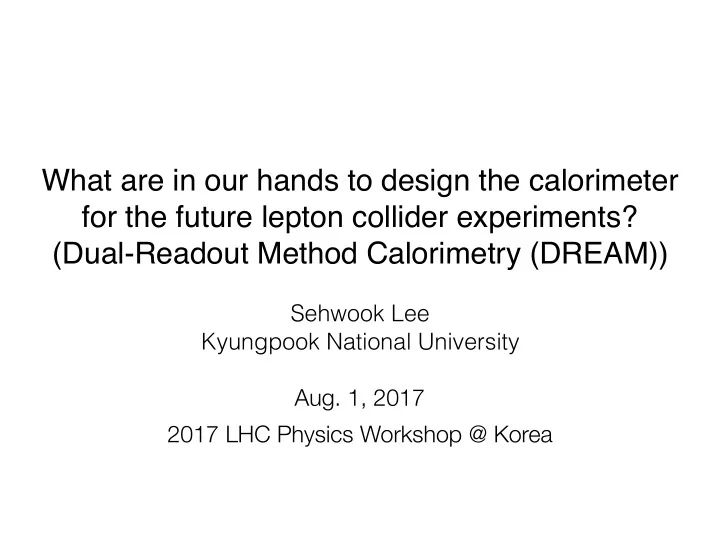

What are in our hands to design the calorimeter for the future lepton collider experiments? (Dual-Readout Method Calorimetry (DREAM)) Sehwook Lee Kyungpook National University Aug. 1, 2017 2017 LHC Physics Workshop @ Korea
Outline • Definitions • Shower Development Physics (EM, Hadronic) • Compensating and Dual-Readout Approaches • Achievements and Plans
Definitions • Thermodynamics: - Calorimetry: Determining the specific heat of water or other substances. - Calorimeters: the thermally isolated boxes containing the substance of our study. • Nuclear and Particle Physics: • Calorimetry: the detection of particles, and measurement of their properties, through total absorption in a block of matter (In the absorption process, almost all particle’s energy eventually converted into heat). • Calorimeter: a block of matter
Electromagnetic Shower (e, γ ) Calorimeter signal is directly proportional to the energy of incoming particles 4
Electromagnetic calorimeters are well understood and offer very precise energy measurement (e, γ detection) “Hadron Calorimeters are usually far from ideal” 5
Hadron Shower • Main fluctuations in hadron calorimetry: • Large, non-Gaussian electromagnetic component fluctuation • Large, non-Gaussian fluctuation in nuclear binding energy loss (“invisible”) 6
Fluctuations of the electromagnetic shower fraction (f em ) Pb Event-to-event fluctuation The em fraction depends on (on average): - pion energy Non-Gaussian, Asymmetric - the type of absorber material 7
Consequence of Main Fluctuations in Hadron Showers • Energy Scale is different from electron, energy dependent • Non-linearity • Non-Gaussian response function • Poor energy resolution 8
Di ff erent Approaches to improve hadronic calorimetry • Compensating calorimeters - designing em and non-em responses are equal ( e/h = 1 ) - hadronic energy resolution of SPACAL: 30 %/ √ E • Dual-Readout calorimeters - measuring f em event by event using Cerenkov light - this approach has been proved experimentally last 15 years 9
SPACAL (Pb/Scintillator Calorimeter) 10
Pros & Cons of Compensating Calorimeter • Pros - Same energy scale for electrons, hadrons and jets. - Calibrate with electrons and you are done. - Excellent hadronic energy resolution (SPACA: 30%/ √ E) - Linearity, Gaussian response function. • Cons - Small sampling fraction (2.4% in Pb/plastic) ➡ limited em energy resolution - Compensating relies on detecting neutrons ➡ Large integration volume ➡ Long integration time (~50 ns)
How can we improve the performance of hadron calorimeters? • Dominant fluctuation: f em - EM shower component almost exclusively produces Cerenkov light - 80 % of non-em energy deposited by non-relativistic particle (non-em component: mainly soft proton) Dual-REAdout Method (DREAM) Measure f em event-by-event with Cerenkov and Scintillation signals 12
Test Beam with the new DREAM modules 9 Pb modules (36 towers, 72 channels), 2 Cu modules (8 towers), 20 leakage counters (Plastic scintillator)
The structures of Pb and Cu modules Pb Cu 14
Electromagnetic Performance
The electromagnetic performance for 40 GeV e - (Cu/fiber) Cu/Scintillation Cu/Cerenkov Independent Structure +
The energy resolution for electrons (Cu/fiber)
Hadronic Performance
DREAM Principle 19
The hadronic performance (Pb/fiber) Dual-REAdout Method = 0.45
The Rotation Method 60 GeV π - 21
The Rotation Method 22
The Rotation Method 23
24
Achievements and Plans • We have proved that DREAM calorimeter can achieve the excellent energy resolutions for both EM and hadrons experimentally . • More results such as particle identification , muon detection , crystal study for DREAM calorimetry and so on: ‣ http://www.phys.ttu.edu/~dream/results/publications/publications.html • For last 15 years, DREAM principle has been proved with experimental data and 31 papers were published. • In July, a summary paper for 15-year R&D results was submitted to Reviews of Modern Physics and is under review. • Based on these R&D results, Korea-Italy-China started simulation efforts to design the calorimeter for the CEPC project in the beginning of 2017 ( C onceptual D esign R eport). • RD52 (DREAM) project will be newly proposed to CERN in the next year, which is associated with the future collider projects.
Backup
A brief history of calorimetry (1) • Particle detection using calorimeter was pioneered in nuclear physics shortly after World War II. • In 1960s: - the transition from the bubble chamber era to experiments based on electronic counters. - In nuclear spectroscopy , high Z material: good energy resolution for γ s . (e.g. NaI(Tl), Ge) • Sampling calorimeters: the construction of large calorimeters. - e.g. absorber: Pb (short radiation length), active material: plastic scintillator, LAr, LKr. - NA48 (Pb-LKr): 3.5%/ √ E, KLOE (Pb-fibers): 4.8%/ √ E (Good energy resolution for e, γ )—1990s. 27
A brief history of calorimetry (2) • In 1970s , the new tasks of calorimeter: the measurement of jet energy and missing E T at the collider experiments (ISR, PETRA) and particle ID (e, γ , μ , ν ). • Calorimeters worked nicely for such tasks and became the main detector at accelerator based particle physics experiments. • However, the energy resolution of hadrons was considerably worse than that of e and γ . The understanding of hadron calorimeter performance was not good enough. • Since ~1985 , the e ff orts to understand the performance of hadron calorimeters has been doing both experimentally and at the Monte Carlo level. 28
Recommend
More recommend